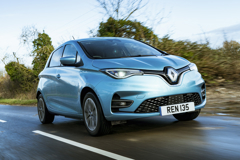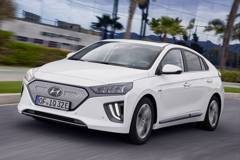MINI E (2010 – 2013) Review
MINI E (2010 – 2013) At A Glance
Big car makers have been talking the talk about electric cars for years, but few have actually tried selling them. Prototypes are made, there are tightly controlled field trials involving ‘partners' such as local authorities, but the cars never reach the showrooms. A good example of this is Peugeot, which built battery-powered 106 superminis in the late 1990s.
Now MINI appears to be going down a similar path. It's built 600 electric examples of its enduringly trendy hatchback. All are left hand drive, with 150kw (the equivalent of a whopping 201bhp) DC electric motors in the front, juiced by lithium-ion batteries so hefty that they take all the space formerly occupied by the rear seats and a large chunk of boot space.
Further compromise can be found at the front -they're all left hand drive- but the company makes no secret that these are prototypes. It canvassed for twenty people living in an area covering London, Oxfordshire and part of Hampshire (MINIs are made in Oxford and this is project partner Southern Electric's stamping ground), to pay £335 a month to lease the cars for six months them give them back, when the exercise will be repeated (something set to happen this spring), provided drivers have a garage to keep ‘their' cars and the associated charging points. An on-street charger isn't an option.
The plan is to get an idea about patterns of use, so Oxford Brookes University academics will be asking questions of its electric vehicle guinea pigs. Anyone wanting to be in the second tranche of users might bear in mind that some 500 people asked to try the cars first time round.
Those whose names are drawn out of the metaphorical hat will be driving cars which are perfectly useable as urban transport; the market niche where most vehicle makers reckon ‘battery electric vehicles' (a.k.a. ‘BEVs') will sell. If nothing else, this Mini is a portent of things to come.
MINI E (2010 – 2013) handling and engines
Electric motors have such huge reserves of go that they don't need conventional transmissions. Power is delivered seamlessly as soon as current is fed to them, and the electric Minis will hit 62 in 9.5 seconds, and can provide instant, shove-in-the-back acceleration, accompanied by a low key electrical whine.
At trundling speeds it's virtually silent, but there's so much power that hard acceleration induces mild torque steer. Its top speed is claimed to be 95mph. The cars drive like conventional, two-pedal automatics; there's a familiar transmission quadrant to select drive, reverse of neutral and reverse, the only real difference comes when lifting off the accelerator, because at this point the motor flips from power taker to battery re-charger, a process known as ‘regenerative braking.' It also helps slow the car, to such an extent that the brakes are usually only needed to bring it to a stop.
Getting the best from the system requires smooth use of the accelerator or deceleration can be a bit jerky, but the technique is easy and painless to master. How far will the car go between charges? In ‘ideal' conditions 156 miles is claimed, with 100-120 flagged up as being more within its normal range. However we do wonder if sustained use of wipers, air con, heating, etc, would bring this down further still.
When the battery is begging for mercy, power to the motor is cut back to that the car can trundle on for a bit longer. Recharging times? MINI reckons four and a half hours for a full electrical top up using the approved re-charging point, although drivers can give it a mini-top up in about two and a half hours. They can even plug it into a regular three pin socket, but that takes ten hours.
This inflexibility remains a bugbear of all-electric cars, but this one's backer claim £1.50's worth of cheap rate power is all it needs for a full charge, and anyone travelling 240 miles a week would pay about £14, compared to £170 in a petrol car returning 35mpg if the fuel costs £1.10 per litre.
Although the electric Mini is thoroughly painless to use and actually fun in the way it handles and delivers its power, the time it needs for re-charging and the huge amount of interior space stolen by its batteries do show up the limitations of the technology it's championing, especially when applied to a car originally designed for conventional engines.
With engineered-from-the-ground-up electric cars it should be possible to free up interior space by sneaking bespoke batteries into areas of the vehicle's structure denied them in this one.
Putting electric motors in wheel hubs -although this throws up other engineering difficulties- would do the same, but until quite recently, there hasn't been the commercial imperative to make such cars and invest in the necessary charging infrastructure.
However, it now looks as if they're finally coming. BMW, MINI's parent, is promising a true, all-electric city car by 2015, and they're not alone in preparing electric models for short hop, city drivers.
Meanwhile the electric MINI shows how well the technology can be made to work, even if for real world drivers it's a bit of a marketing fig leaf.
Model History
January 2010
The British government body that exists to promote business innovation in technology announced that a consortium led by BMW Group will be supported by a proportion of a £25m fund, enabling the MINI E to be introduced and tested on British roads by a mixture of private, corporate and public sector drivers before the end of 2009. The objective of the Technology Strategy Board is to encourage manufacturers to develop ultra-low carbon vehicles that customers want to buy and bring them to market as rapidly as possible.
MINI E models will be on UK roads for a twelve-month field trial that will evaluate the technical and social aspects of living with an all-electric vehicle in a real world environment. This year-long project will play an important part in informing future strategic and technological decisions. BMW Group is bringing together an energy infrastructure provider and an academic partner, with the support of a regional development agency and local authorities, to make the MINI E research project a reality in the UK.
The MINI E UK Research Consortium, of which BMW Group is the lead partner, comprises several organisations which are based around Oxford and the South-East of England. All will play important roles in the collaborative field trial.
In addition to the BMW Group, the consortium includes an electric energy and infrastructure provider (Scottish and Southern Energy), an academic partner (Oxford Brookes University’s Sustainable Vehicle Engineering Centre) and the South East England Development Agency (SEEDA) as well as Oxford City Council and Oxfordshire County Council.
Scottish and Southern Energy, the UK’s leading generator of energy from renewable sources, will be responsible for providing the infrastructure in and around Oxford and other locations in the South-East of England by installing the private and public charging points that will be required to recharge the batteries in the MINI E test vehicles.
Oxford Brookes University, under the direction of Professor Allan Hutchinson who leads its Sustainable Vehicle Engineering Centre, will be responsible for undertaking scientific data analysis as well as conducting customer surveys to capture the subjective feedback from users of the MINI E test vehicles.
At the end of the trial, a comprehensive report documenting the main findings of the MINI E research project will be published. This will help inform those bodies seeking to create the political, technical and commercial framework necessary to enable sustainable mobility in a low carbon future to become reality.
Electric mobility is just one of the low carbon technology options being investigated by BMW Group. The company aims to begin series production of all-electric vehicles before the middle of the next decade as part of the company’s Strategy Number ONE.
The MINI E’s electric drive train produces a peak torque of 220 Nm, and power is delivered to the front wheels via a single-stage helical gearbox. This unique engine and transmission arrangement powers the MINI E seamlessly to 62 mph in 8.5 seconds and on to an electronically-limited top speed of 95 mph.
Based on the current MINI Hatch, the car is available as a two-seater. With 204 hp at the driver’s disposal, performance is close to that of the MINI John Cooper Works.
The space normally inhabited by rear passengers is reserved for a lithium-ion battery. The heavy-duty battery delivers its power to an electric motor which is mounted transversely under the MINI E’s bonnet. This power unit is able to unleash its full thrust from a dead standstill and is complemented by its dynamic deceleration potential, which is directly coupled to the accelerator pedal.
The MINI E’s lithium-ion battery can be plugged into all standard power outlets. Its charge time is strongly dependent on the voltage and amperage of the electricity flowing through the grid. As with existing research projects in the USA and Berlin, users will be able to recharge a battery that has been completely drained within a very short period of time using a wallbox that will be supplied as standard with every MINI E. With 240V/32A, charging time for the car will be around four hours. There is also an intention to establish a network of public charging stations.
The wallbox will be installed in the customer’s garage, enable higher amperage and thus ensure extremely short charging times. Wallboxes fully recharge batteries in just four-and-a-half hours. Only lockable garages or similar buildings will qualify as suitable power stations for the MINI E.
Besides the benefit of zero-emissions driving, the MINI E offers significant economic advantages over a vehicle powered by a conventional internal combustion engine. Fully re-charging the battery using off-peak electricity at current prices will cost around £1.50. Using higher-rate daytime electricity, the cost will still be less than £4.00.
The MINI E’s 1,465 kilograms is evenly distributed across the car. Modifications to the suspension system and the car’s Dynamic Stability Control (DSC), adapted to the car’s specific wheel loads, ensure safe and dynamic handling typical of MINI.
Production of all cars for the UK trial is underway at the company’s Oxford and Munich sites. MINI’s Plant Oxford will be responsible for manufacturing the entire vehicle on the standard production line, with the exception of the drive components and the lithium-ion battery. The vehicles will then be transferred to a specially equipped manufacturing facility situated on BMW plant premises in Munich where the electric motor, battery units, performance electronics and transmission will be integrated.

.jpg?width=640&height=426&rmode=crop)
.jpg?width=640&height=426&rmode=crop)
.JPG?width=640&height=426&rmode=crop)
.jpg?width=640&height=426&rmode=crop)
.JPG?width=640&height=426&rmode=crop)
.jpg?width=640&height=426&rmode=crop)



 All electric MINI, good performance, claimed range of 156 miles, ideal for town, zero tailpipe emissions.
All electric MINI, good performance, claimed range of 156 miles, ideal for town, zero tailpipe emissions.
 Just two seats, only available via a trial at the moment.
Just two seats, only available via a trial at the moment.


.jpg?width=240&height=160&rmode=crop)

